 |
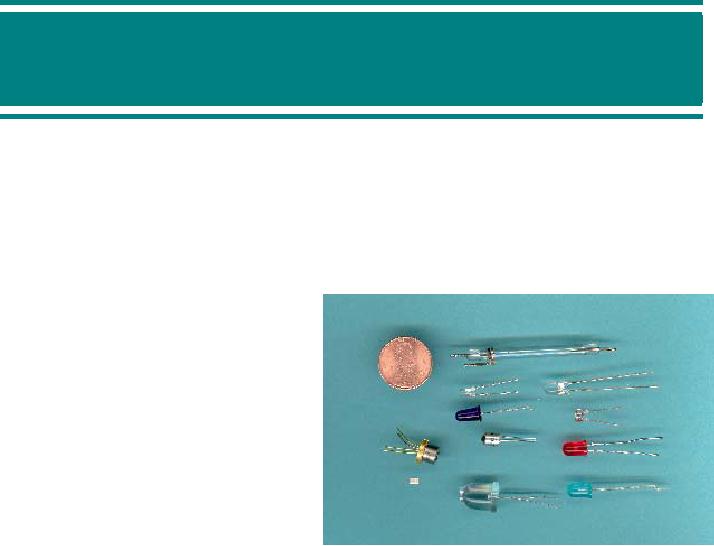
Chapter
Three
LIGHT
EMITTERS
Introduction
to Light Emitters
Unlike
the limited number of
useable light detectors, there is a
wide variety of light
emitters that
you can
use for optical
through-the-air communications. Your
communications system will
depend
much
more on the type of light
source used than on the
light detector. You should
choose the light
source
based on the type of
information that needs to be
transmitted and the distance you
wish cover
to
reach the optical receiver. In
all cases the light source
must
be
modulated (usually turned on
and
off
or varied in intensity) to transmit
information.
The
modulation rate will determine
the
maximum
rate information can be
transmitted.
You may have to make
some
tradeoffs
between the modulation
rates
needed,
the distance to be covered and
the
amount
of money you wish to
spend.
Many
light sources listed below
are useful
for
low to medium speed
modulation rates
and
can have ranges up to several
miles. A
few
others are ideal for
low speed
telemetry
transmission that can reach
beyond
50 miles. If you need high
speed
Samples
of Emitters
information
transmission, there are only
a
few
choices, and those tend to be expensive.
But, as the technology
improves the prices
should
come
down. I have also described
some of the latest devices
that may become available to
the
experimenter
in a few years, but only
demonstration devices exist
today.
Light
Emitting Diodes
(LEDS)
For
most through-the-air communications
applications the infrared
light emitting diode (IRLED)
is
the
most common choice. Although
visible light emitting devices do
exist, the infrared parts
are
generally
chosen for their higher
efficiency and more favorable
wavelength, especially when
used
with
silicon photodiode light
detectors.
GaAlAs
IR LED
GaAlAs
(gallium, aluminum arsenic)
infrared LEDs are the
most widely used modulated
IR light
sources.
They have moderate electrical to
optical efficiencies, (at
low currents 4%), and
produce
light
that matches the common
silicon PIN detector
response curve (900nm). Most
devices can be
pulsed
at high current levels, as
long as the average power
does not exceed the
manufacturer's
maximum
power dissipation specification
(typically 0.25 watts). Some
devices can be pulsed up to
10
amps, if the duty cycle
(ratio of on time to the
time between pulses) is less
than 0.2% (0.002:1
ratio).
Some of the faster devices
have response times that
allow them to be driven with
current
Page
23
of 68
Optical
Through-the-Air Communications Handbook
-David A. Johnson, PE
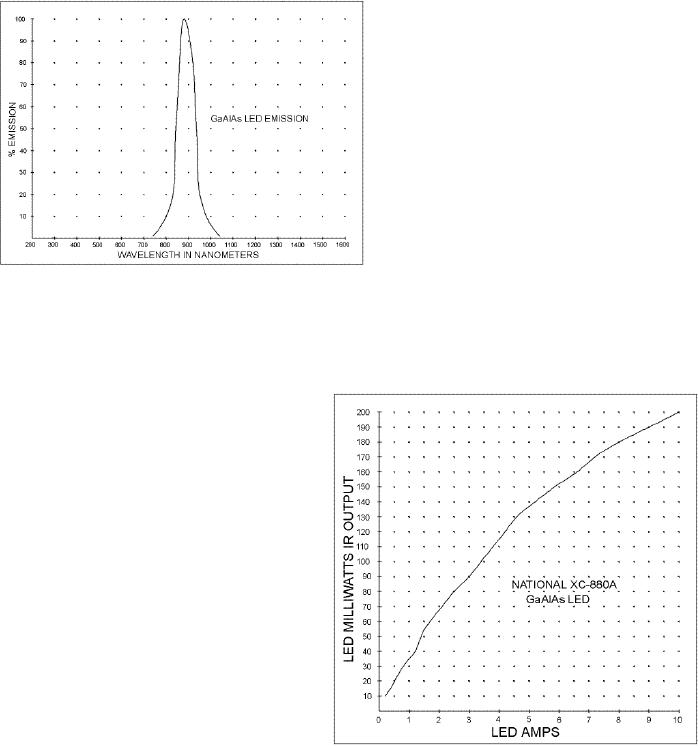
pulses
as short as 100 nanoseconds
but
most
devices require at least
900
nanoseconds.
At a current level of about
6
amps
a quality device can emit
about 0.15
watts
of infrared light. However, at
higher
current
levels their efficiency is
generally
poor,
dropping to less than 0.5%
(See
Figures
3a, 3b, 3c and 3d.)
Many
resemble
the commonly used visible
LEDs
and
will typically be packaged in
molded
plastic
assemblies that have small
3/16"
lenses
at the end. The position of
the
actual
LED chip within the
package will
determine
the divergence (spreading
out)
of
the exiting light. The
typical T-1 3/4
Figure
3a
style
device will have a half
angle divergence ranging
from 15 to 40 degrees. They
are low cost,
medium
speed (up to 1 million pulses per second)
sources, with long operating
lifetimes (typically
greater
than 100,000 hours).
They
are a good choice for short
and
medium
distance control links and
general
communications
applications. When
used
with
a large lens, a single
device can be
used
for a communications system
with a
multi-mile
range. Multi-device arrays can
also
be constructed to transmit
information
over
wider areas or longer distances.
They
generally
cost between $0.30 to $2.00
each
and
are
available
from
many
manufacturers.
GaAs
IR LED
These
devices are the older and
less
efficient
cousin to the GaAlAs
devices.
They
come in all styles and shapes.
The
more
useful devices have smaller
emitting
surfaces
than GaAlAs LED's,
permitting
narrow
divergence angles with
small
Figure
3b
lenses.
Also, the small emitting
areas make
them
very useful for fiber
optic applications. Some
commercial devices have miniature
lenses
cemented
directly to the semiconductor
chip to produce a small
exiting light angle
(divergence
angle).
In conjunction with a small
lens (typically 0.5") such
devices can launch light with a
narrow
divergence
angle (0.5 degrees). The
most important feature of
the GaAs LED is its
speed. They are
generally
10 times faster than GaAlAs
LED's but many only
produce 1/6 as much light.
They are
often
picked when medium speed
transmission over short
distances is required. Their
price is
typically
a little more than the
GaAlAs LED's, even though
they use an older
technology. They will
cost
between $2.00 to
$25.00.
Page
24
of 68
Optical
Through-the-Air Communications Handbook
-David A. Johnson, PE
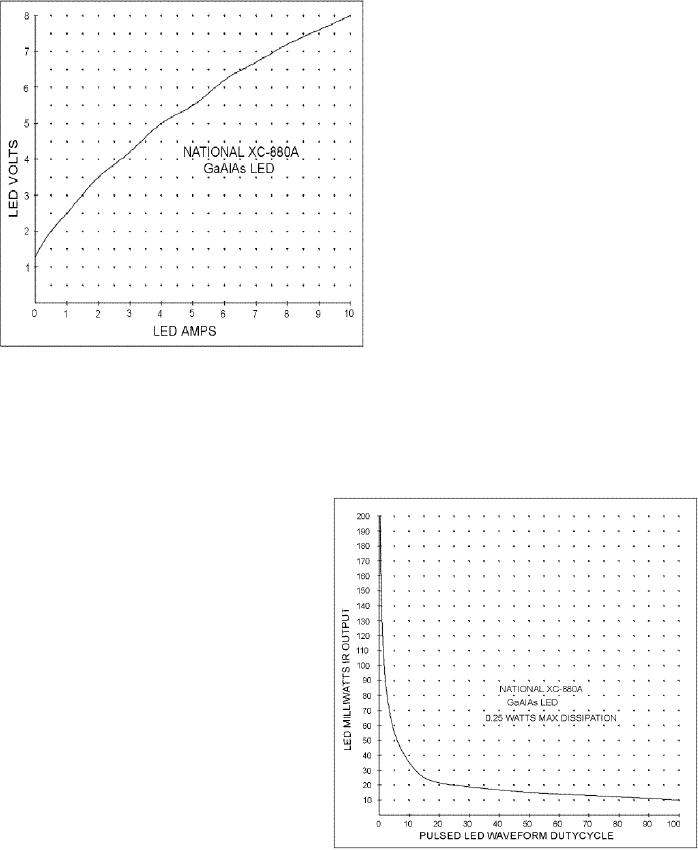
GaAsP
Visible Red LEDs
Although
not as efficient as the
infrared
devices
some visible red LEDs
(Figure
3d-1)are now
available, that might
find
limited
use in some short range
through-
the-air
applications. Some so called
"super
bright"
LEDs boast high light
output.
However,
even the brightest
components
will
still produce only 1/3 as
much light as
a
quality infrared
part.
Also,
since their light is a visible red
color,
an
automatic 2:1 penalty will be paid
when
the
devices are used with a
standard
silicon
detector that has a weaker
response
to
red light. The visible red
LEDs are
generally
faster (up to 2 million pulses
per
second)
than IR components and can
therefore
be used for medium
speed
Figure
3c
applications.
Also, since their light
is
visible,
they are much easier to
align than invisible IR devices,
especially when the devices
are used
with
lenses.
Solid
State Semiconductor
Lasers
GaAs
(Hetrojunction) Lasers
These
devices have been around since
the
1960s
and can produce very powerful
light
pulses.
Some devices are able to
launch
light
pulses in excess of 20 watts, which
is
some
200 times more powerful than
a
typical
GaAlAs LED. But, these
devices
can
only be driven with duty
cycles, less
than
0.1% (off time must be 1000
times
longer
than on time). Also, their
maximum
pulse
width must be kept short
(typically
less
than 200 nanoseconds) even
under
low
pulse rate applications.
However,
despite
their limitations these devices
can
be
used in some voice
transmitter systems
if
some careful circuit designs
are used.
As
in most semiconductor lasers, the
GaAs
laser
does require a minimum
current level
Figure
3d
(typically
10 to 20 amps) before it begins
emitting
useable light. Such high
operating currents demand more
complicated drive
circuits.
Despite
a 10:1 sensitivity reduction,
caused by the rather narrow
emitted pulses (see receiver
circuit
discussion),
the more powerful light
pulses available from GaAs
lasers can increase the
useful range
of
a communications system by a factor of
about 3, over a typical
transmitter using a single
LED. In
Page
25
of 68
Optical
Through-the-Air Communications Handbook
-David A. Johnson, PE
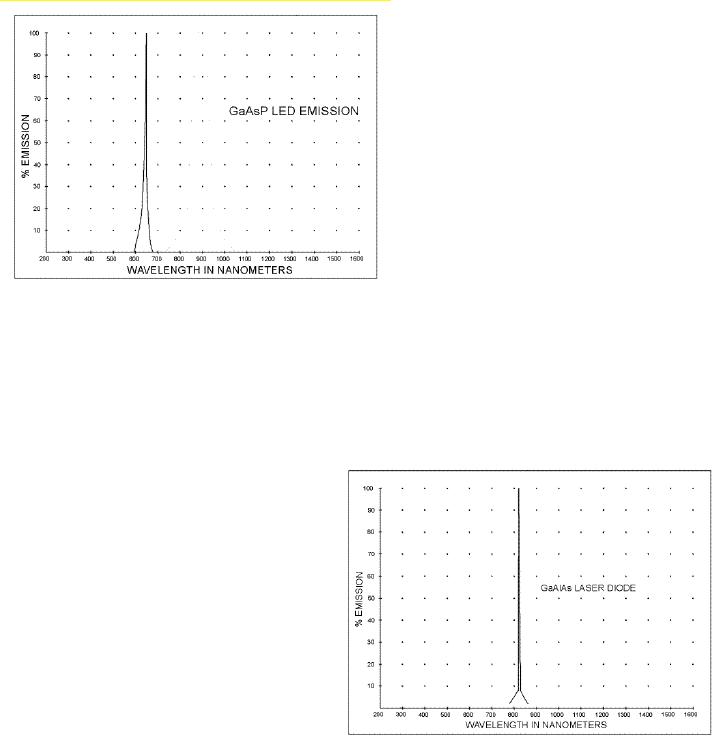
addition,
since their emitting spot sizes
are
very
small, they can also be focused
into
very
tight beams using rather
small lenses.
In
addition, since their spectral
widths are
very
narrow the matching light
detector
circuit
can use an optical band pass
filter
to
reduce the noise levels associated
with
ambient
light (see receiver circuit
section).
For
low speed and
long distance
applications,
the GaAs laser should
be
considered.
However, they do have
some
disadvantages.
They typically cost
much
more
than a GaAlAs LED (up to
$75).
They
have shorter lifetimes (may
only last
a
few hundred hours) and are
sensitive to
Figure
3d-1
temperature.
Therefore, they require a
carefully designed transmitter
circuit that can switch 20
or
more
amps at high speeds and can
compensate for changes in
operating temperature.
GaAlAs
(CW) Lasers
These
are the latest in infrared
light emitting semiconductor devices and
are rapidly maturing.
The
first
wide spread application for
these devices was in audio compact
disk players and CD-
ROM
computer disk drives. They
are also
being
used in some computer
laser
printers,
bar code readers and FAX
machines.
They have very small
emitting
areas,
can produce peak power
levels in
excess
of 0.2 watts and have
narrow
spectral
bandwidths (see Figure
3e.)
The
most
important improvement over
other
light
sources is that they can be
modulated
at
frequencies measured in
gigahertz.
However,
as in any new technology
they
are
still rather expensive. Low
power units
that
emit less than 0.01
watts of 880nm
infrared
light, sell for about
$20.00. Some
of
the more powerful devices can cost
as
Figure
3e
much
as $20,000 each. Although the
use of a laser in a communications system
might give a project
a
high tech sound, a much
cheaper IR LED will almost
always out-perform a low
power laser
(typical
LED will be able to emit 10 times
more light at 1/10 the
cost) in low to medium
speed
applications.
But, when very high-speed
modulation rates (up to 1
billion pulses per second) are
needed,
these devices would be a good
choice.
Although
expensive now, these devices
should come down in price
over the next few years.
They
will
also most likely be available at
higher power levels too.
But, until then, their
advantages do not
justify
their expense and the more
useful high power units
are beyond the reach of
practical
experimental
designs. I suggest using these devices
only when necessary.
Page
26
of 68
Optical
Through-the-Air Communications Handbook
-David A. Johnson, PE
Surface
Emitting Lasers
(VCSEL)
These
devices are just now
beginning to appear in some catalogs.
Many companies have
been
experimenting
with these latest
semiconductor devices since about 1988.
Their small size and
high
efficiency
make them very suitable for
some applications. They are
mostly used in optical
fiber
communications.
Instead of being grown as
single chip emitters, these
devices are fabricated
into
large
arrays of very small
individual laser sources sharing a
common substrate. Since the
individual
laser
diode emitters can be as small as one
micron (1/10,000cm) as many as 100
million separate
devices
could be placed into a 1cm X
1cm area.
The
output efficiency (electrical
power to light power) has
been reported to be about
40%, with
each
tiny device emitting about
0.003 watts. Although each
device may emit only a
small amount of
light,
when used as an array, 100
million such devices could
launch some 100,000 watts of IR
light
from
about 200,000 watts of electricity. Of
course, cooling such a powerful
array would be a real
challenge,
if not impossible. But,
perhaps smaller arrays could
be placed into common
semiconductor
packages for easy mounting
and cooling. Maybe a 0.1-watt
device would be placed
into
inexpensive LED style
packages. Other devices may be
mounted in better heat
conducting
metal
packages to allow perhaps 100
watts of light to be emitted. Since
their maximum
modulation
rates
have been measured in the
multi-billion pulses per second rate,
surface-emitting lasers
would
be
ideal for many future
through-the-air communications
applications. They would
especially be
useful
in broadcasting optical information over
a citywide area, where very
powerful high-speed
light
sources are needed. A
10,000-watt source, emitting light in a
specially shaped
360-degree
pattern,
might be able to transmit information
over an area covering some
500 square miles. Such
a
broadcasting
system might be used to
transmit library type
information from large
centralized
databases.
Externally
Excited Solid State
Lasers
Some
of the very first lasers
made were the Ruby and YAG
lasers. Most of these lasers
are excited
externally
using large xenon flash
tubes that are positioned
around the central glass
laser rod. A
small
portion of the light from
the xenon flash excites
the specially positioned rod
material, forming
short
coherent light pulses. Although
these lasers are capable of
emitting very power light
pulses,
with
very narrow divergence angles,
they are generally much
too expensive and too
complicated for
the
average experimenter. They
would therefore find very
limited use in earth-bound
optical
communications.
However, some scientists
believe that the extremely
powerful light pulses
that
these
devices are capable of producing,
might be useful in transmitting
information into very
deep
space.
Since some pulsed lasers
have been reported to launch
light pulses approaching one
terawatt
(1000
billion watts), low speed
communications might be possible to a range of
several light years
(one
light year = 6 trillion
miles). Such a feat would be
very difficult to accomplish
with microwave
techniques.
Gas
Lasers
Helium-neon,
carbon dioxide and argon are
the more common types of
gas lasers. The light
emitted
from
a gas arc, inside a glass
tube, is bounced back and
forth through the excited
gas using specially
fabricated
mirrors. A portion of the
light is allowed to escape
through one of the mirrors
and
emerges
as very monochromatic (one
wavelength) and highly coherent
(same phase) light.
Such
lasers
have narrow divergence angles
(typically less than 0.1
degrees) but have very
low conversion
efficiencies
(much less than 0.1%).
They are also expensive and
bulky that makes them
impractical
for
most optical communications
applications. Some published
designs that did
provide
experimental
optical communications using
helium-neon lasers were
designed to transmit
voice
Page
27
of 68
Optical
Through-the-Air Communications Handbook
-David A. Johnson, PE
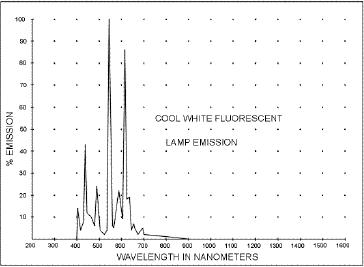
audio
information over a range of only a
few miles. The modulation
technique was to vary the
gas
arc
current that then produced a
light intensity modulation.
However, the extra cost and
relative low
power
that resulted usually did
not warrant the trouble. A
properly designed system
using a single
LED
will usually out perform any
short-range helium-neon laser
communications system at a
fraction
of the cost.
Although
too expensive for the
experimenter, some gas
lasers have been used by
the military for
many
years. In particular, carbon dioxide
lasers, that emit long
infrared wavelengths
(10,000
nanometers),
have been used in some
military targeting systems. The
long infrared wavelength
can
penetrate
smoke and fog better than
visible or near IR lasers. Also, the
Navy has been
experimenting
with some blue-green laser
light to attempt to provide
communications to
submarines
deep under water. But,
overall gas lasers fall
short of the ideal for
practical through-the-
air
communications.
Fluorescent
Light Sources
Fluorescent
Lamps
Fluorescent
lamps work on the principle
of
"fluorescence"
and because of their
low
cost
have
many
through-the-air
applications.
An electrical current
passed
through
a mercury vapor inside a
glass
tube
causes the gas discharge to
emit
ultraviolet
"UV" light. The UV
light
causes
a mixture of phosphors, painted
on
the
inside wall of the tube, to
glow at a
number
of visible light wavelengths
(see
Figure
3f.) The
electrical to optical
conversion
efficiency of these
light
sources
is fairly good, with about 3
watts
of
electricity required to produce
about 1
watt
of light. A cathode electrode at
each
Figure
3f
end
of the lamp that is heated
by the discharge current, aids in
maintaining the discharge
efficiency,
by
providing rich electron sources. By
turning on and off the
electrical discharge current, the
light
being
emitted by the phosphor, can be
modulated. Also, by driving
the tubes with higher
than
normal
currents and at low duty
cycles, a fluorescent lamp can be
forced to produce powerful
light
pulses.
However, like the pulse
techniques used with LEDs,
the fluorescent lamp pulsing
techniques
must
use short pulse widths to
avoid destruction of the
lamp.
To
modulate a fluorescent lamp to
transmit useful information,
the negative resistance
characteristic
of
the mercury vapor discharge
within the lamp must be
dealt with. This requires
the drive circuit to
limit
the current through the
tube. The two heated cathode
electrodes of most lamps also require
the
use
of alternating polarity current pulses to
avoid premature tube
darkening. The typical
household
fluorescent
lighting uses an inductive
ballast method to limit the
lamp current. Although such
a
method
is efficient, the inductive
current limiting scheme
slows the rise and fall
times of the
discharge
current through the tube and
thus produces longer then
desired light pulses. To achieve
a
short
light pulse emission, a
resistive current limiting
scheme seems to work better.
In addition,
there
seems to be a relationship between
tube length and the maximum
modulation rate. Long
tubes
do
not respond as fast as shorter
tubes. As an example, a typical
48" 40 watt lamp can be
modulated
Page
28
of 68
Optical
Through-the-Air Communications Handbook
-David A. Johnson, PE
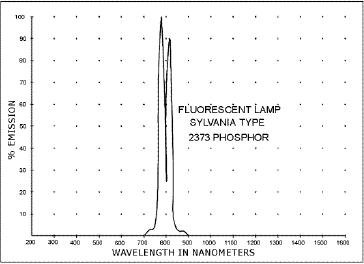
up
to about 10,000 pulses per second,
but
some
miniature 2" tubes can be driven
up
to
200,000 pulses per second. The
main
factor
that ultimately limits the
modulation
speed
is the response time of the
phosphor
used
inside the lamp. Most
visible
phosphors
will not allow pulsing
much
faster
than about 500,000 pulses per
second.
The visible light emitted by
the
typical
"cool white" lamp is also
not ideal
when
used with a silicon
photodiode.
However,
some special infrared
light
emitting
phosphors could be used
to
increase
the relative power output
from a
fluorescent
lamp, which may also
produce
Figure
3g
faster
response times. (see
Figure
3g.)
If
a conventional "cool white"
lamp is used, a 2:1 power
penalty will be paid due to the
broad
spectrum
of visible light being
emitted (see Figure
3f.) This
results since the visible
light does not
appear
as bright to a silicon light
detector as IR light (see
section on light detectors).
Also, light
detectors
with built-in visible
filters should not
be
used, since they would not
be sensitive to the
large
amount of visible light
emitted by the lamps.
Although the average
fluorescent lamp is not
an
ideal
light source, the relative
low cost and the large
emitting surface area make it
ideal for
communications
applications requiring light to be
broadcasted over a wide
area. Experiments
indicate
that about 20 watts of light
can be launched from some
small 9-watt lamps at
voice
frequency
pulse rates (10,000/sec).
Such power levels would
require about 100 IR LEDs
to
duplicate.
But, the large surface
emitting areas of fluorescent
lamps makes them impractical
for
long-range
applications, since the light
could not be easily
collected and directed into a
tight beam.
(For
additional information see
section on fluorescent lamp
transmitter/receiver circuits.)
Cathode
Ray Tubes (CRT)
CRTs
work somewhat like
fluorescent lamps, since they
too use fluorescence
emission techniques.
Electrons,
emitted from a heated cathode end of
the cathode ray vacuum tube,
are accelerated
toward
the anode end by the force
of a high voltage applied
between the cathode and
anode
electrodes.
Before hitting the anode
screen, the electrons are
forced to pass through a
phosphor
painted
onto the inside of the
screen. In response to the high-speed
electrons, the phosphor
emits
light
at various wavelengths. A voltage
applied to a special metal grid near
the tube's cathode end is
used
to modulate the electron
beam and can thus produce a
modulation in the emitted
light. This
principle
is used in most computer and TV
screens. Since the electron
beam can be modulated at
very
high rates, the light source
modulation rate is limited only by
the response time of
the
phosphor
used. Depending on the type
of phosphor, the electrical to
optical efficiency can be as
high
as 10%. Some specially made
cathode ray tubes produce powerful broad
(unfocused) electron
beams
that illuminate the entire
front screen of the CRT
instead of a small dot. Such tubes can
yield
powerful
light sources, with large
flat emitting areas. A
variation on the usual
television type CRT
design
positions a curved phosphor
screen at the back of the
vacuum tube and places the
cathode
electrode
at the front or side of a
clear glass screen (some
portable Sony TVs use
such CRTs). This
technique
increases the overall
efficiency, since it allows the
light from the phosphor to
exit from
the
same side as the electron
source. With the aid of external
cooling, such techniques
could create
Page
29
of 68
Optical
Through-the-Air Communications Handbook
-David A. Johnson, PE
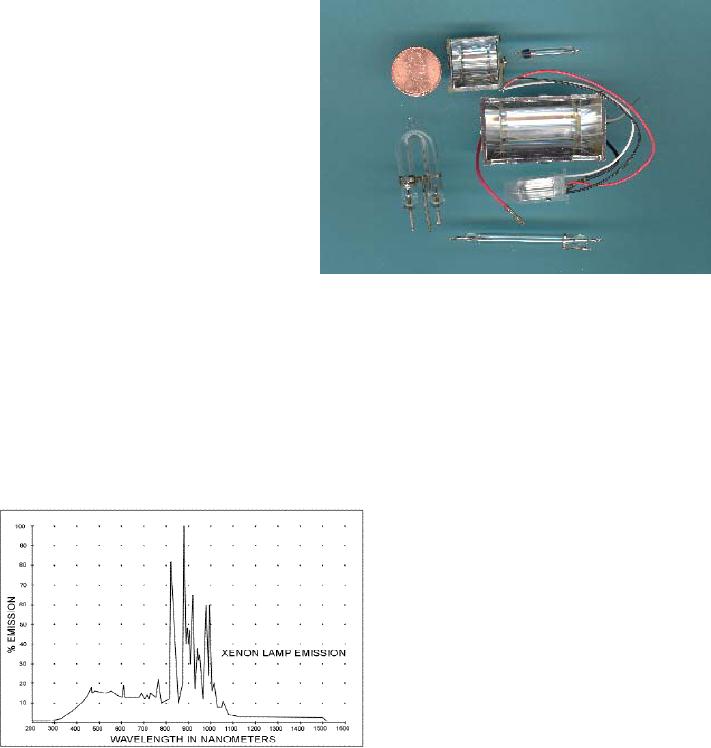
very
powerful light sources that
might be able to launch tens of thousands
of watts of light,
pulsed
at
rates exceeding tens of millions of
light pulses per second. Although the
typical experimenter
may
not be interested in such
light power levels it does
raise some interesting
possibilities for use
in
city
wide optical
communications.
Gas
Discharge Sources
Xenon
Gas Discharge Tubes
The
most common form of this
class of
light
source is the electronic camera
flash.
These
devices are some of the
most
intense
light sources available to
the
experimenter
and have many
interesting
applications.
The discharge lamps
are
typically
made from a glass tube
with a
metal
electrode installed at each
end. They
are
filled with xenon gas at
about one
atmosphere
of pressure (14psi). The
gas
inside
the tube can be made to glow
with
very
high intensity when an
electrical
current
is passed through it.
Xenon
Lamps
As
illustrated in Figure
3h, the
xenon arc
emits
light over a broad spectrum
with some large peaks in
the near infrared range. The
electrical to
optical
conversion is fairly good. A
typical camera flash can
produce about 2,000 watts of
light
from
about 10,000 watts of
electrical power (20%
efficiency). Some specially
made discharge tubes
can
generate flashes that exceed
one million watts of light
power. As in fluorescent lamps,
the
minimum
flash duration is somewhat dependent on
the length of the discharge
tube. A typical
camera
flash tube has an electrode
gap of about 15mm (0.6") and
will usually produce a
flash,
which
lasts about one millisecond. The
energy used to produce the
short flash comes
from
discharging
a special capacitor, charged to
several
hundred volts. By decreasing
the
size
of the capacitor (say to 6
microfarads)
and
increasing the voltage (say
to 300
volts)
the camera flash tube can be
made
to
produce flashes as short as
20
microseconds.
Shorter discharge flashes
are
only possible by using specially
made
discharge
tubes with very narrow
electrode
gaps
(0.5mm). These narrow gap
lamps
can
produce flashes as short as one
half
microsecond.
However, the physics of
the
xenon
gas arc prevents flashes
much
shorter.
Figure
3h
Flash
rates up to 10,000 per second
are
possible
with the short gap
lamps, but the typical
camera flash tube can't be
pulsed much faster
than
about
100 flashes per second. Since some special
high speed lamps can
dissipate up to 75 watts of
average
power, it is possible to design an optical
voice information transmitter
which could launch
Page
30
of 68
Optical
Through-the-Air Communications Handbook
-David A. Johnson, PE
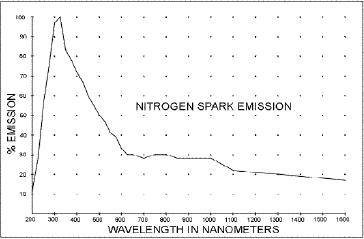
as
much as 1000 watts of light
with a narrow divergence.
Such a transmitter would
certainly have
some
long-range possibilities. However,
most xenon discharge lamps
are more useful for
low speed
and
long-range applications, requiring
very powerful light pulses.
Many years ago, I constructed
a
demonstration
telemetry system that
launched very powerful light
pulses at a low data rate that
had
a
useable range of 50 miles. (See
discussion on long-range telemetry
transmitters using xenon
flash
sources.)
Nitrogen
Gas (air) Sparks
For
very powerful and very short
light pulse applications, a
simple electrical spark in air can
be
used.
Some simple systems use two
closely spaced (0.5mm) electrodes
(usually made of
tungsten)
in open air. With
sufficient
voltage,
the air between the
electrodes can
be
made to ionize briefly,
forming a small
spark.
Some gas barbecue grill
igniters
that
use piezoelectric crystals to
produce
the
needed high voltage, can be
modified
to
produce useful sparks
for some
experiments.
Commercially made
nitrogen
spark
sources claim to generate
light
flashes
that pack about 100,000 watts
of
light
power into short 5
nanosecond
pulses.
The
nitrogen (air) arc emits a
broad
Figure
3i
spectrum
of light with large peaks in
the
visible
blue and invisible ultraviolet
(see Figure
3i.) Such a
spectrum is not ideal when
used with
silicon
detectors. But the small
emission areas of the sparks
allow simple lenses or
mirrors to be
used
to form very tight
divergence angles. But, the
air ionization (sparking) can be
become very
unstable
at high pulse rates, without
using specially made discharge tubes and
drive circuits.
Therefore,
the sparks are best
used for powerful, very
short pulse applications
that demand only low
pulse
rates. Optical radar, electronic distance
measurements, air turbulence monitors and
wind shear
analysis
are some possible uses for
such a light source. You shouldn't be
fooled by the
seemingly
dim
appearance of these light
emitters. To our human eyes
the tiny flashes may
not seem very
bright,
but to a fast detector they
can be very powerful. However, to take
advantage of these unique
pulses,
a fast light detector and an
equally fast amplifier must
be used. Since few experiments
have
been
conducted with these unique
light sources, it is a great area for
the experimenter to see
what
can
be done.
Other
Gas Discharge Sources
Glass
discharge tubes filled with Cesium,
Krypton or Rubidium will all
produce lots of
infrared
light.
Krypton behaves much like
Xenon and has a very similar
emission output. Cesium
and
Rubidium
are both semi-liquids at
room temperatures and can be operated
under high or low
pressures
in a discharge lamp. Such lamps
might be constructed in a similar
manner to the more
common
yellow color sodium vapor
street lamp. Cesium, in particular,
appears to be a good
candidate
for some experimentation in
developing some powerful
light sources with high
peak
power
outputs. Since kilowatt size sodium
vapor street lamps are being
manufactured, perhaps
similar
lamps using cesium could be
made. Such lamps might be
able to produce multi-kilowatts of
modulated
infrared light using pulse
methods.
Page
31
of 68
Optical
Through-the-Air Communications Handbook
-David A. Johnson, PE
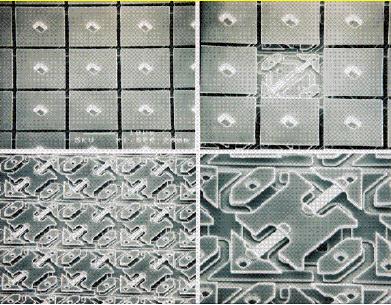
External
Light Modulators
Ferroelectric
light valves, modulated
mirror arrays, piezoelectric
shutters, Kerr cells, Pockels
cells,
Bragg
cells and liquid crystals
are all light modulators.
They can be used to intensity
modulate light
being
emitted by an external source as it
passes through them or
reflects off them. The
light can
originate
from incandescent lamps, CW xenon
gas arc lamps, light from a
gas laser or even
focused
sunlight.
Although usually very
expensive, some of the devices can be
used to produce
powerful
modulated
light signals at high pulse
rates.
Liquid
crystal modulators are
perhaps the slowest of the
group. Most can't be driven
much faster
than
about 100 flashes per second.
Ferroelectric light valves and
piezoelectric shutters are a
little
faster
and can be pushed to perhaps 10,000
flashes per second. Kerr cells,
Bragg cells and
Pockel
cells,
on the other hand, are
known to be very fast.
However, they work best
when used with laser
light
at a specific wavelength and at narrow
angles. Some of these devices can
modulate the light
from
a laser at rates beyond 100 million
pulses per second. But, most of these
devices are very
expensive,
are complicated and are
therefore impractical for
the average
experimenter.
A
new device developed by
Texas
Instruments
(Figure
3j) has
some
interesting
possibilities. The
technology
was
originally developed for
flat panel
computer
and TV displays, but
the
techniques
might be useful for
optical
communications.
TI's process fabricates
a
large
array of very small mirrors
that can
be
moved using a voltage
difference
between
the mirror and an area
behind the
mirror.
Like tiny fans, each
mirror would
wave
back and forth in response to
the
drive
voltage. Because the mirrors
are very
small,
the modulation rates might
be
pushed
to perhaps 100,000 activations per
second.
If the mirrors were used to
reflect
light
from an intense light
emitter, a nice
source
of modulated light could
be
Figure
3j
produced.
Page
32
of 68
Optical
Through-the-Air Communications Handbook
-David A. Johnson,
PE
Table of Contents:
- LIGHT THEORY:The Spectrum, Human Eye Response, Silicon Detector Response
- LIGHT DETECTORS:The Silicon PIN Photodiode, Active Area, Response Time
- LIGHT EMITTERS:Light Emitting Diodes (LEDs), Solid State Semiconductor Lasers
- LIGHT SYSTEMS CONFIGURATIONS:Opposed Configuration, Diffuse Reflective Configuration
- LIGHT PROCESSING THEORY:Lenses as Antennas, Light Collimators and Collectors
- OPTICAL RECEIVER CIRCUITS:Current to Voltage Converter Circuits, Post Signal Amplifiers
- OPTICAL TRANSMITTER CIRCUITS:Audio Amplifier with Filters, Pulsed Light Emitters